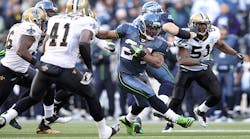With his team leading 34-30 in the final minutes of a wild card playoff game against the New Orleans Saints in 2011, Seattle Seahawks running back Marshawn Lynch took a handoff and exploded through the hole, beginning what would turn out to be a 67-yard touchdown run.
Sitting a few thousand miles away on a tiny island at North Tonawanda, N.Y., just outside of Niagara Falls, Douglas P. Taylor, CEO of Taylor Devices, no doubt looked at Lynch’s run through a different lens than most Seahawks fans that day. Taylor’s daily job involves controlling and stopping the movement of masses. No, he’s not a linebacker, he’s an engineer, and his company manufactures seismic dampers that protect structures during such events as earthquakes and high winds. He is inventor or co-inventor of 34 patents in the fields of energy management, hydraulics and shock isolation. In 2015, he was inducted into the Space Technology Hall of Fame by NASA and the Space Foundation.
As Lynch rumbled down the sideline for the game-winning touchdown, something else was rumbling in Seattle that day. His run led to such a frenzy in the stands that jumping fans caused a 1.0 earthquake to register at the Pacific Northwest Seismic Network.
Lynch helped set off seismic alarms again in 2014 on touchdown run, and football fans of another sort on the other side of the pond got into the act earlier this year, causing what amounted to a 1.0 Earthquake in Spain in celebration of an FC Barcelona win.
Taylor’s firm wasn’t involved in the construction of either facility in Seattle or Barcelona, but it was heavily involved with BC Place, a new stadium in Vancouver, and Safeco Field, the retractable roof stadium that serves as the home of the Seattle Mariners.
“Those who are going to sporting events should be made aware that technology already exists to protect a structure and its occupants during wind and seismic events,” Taylor says. “My hope is that a fan’s biggest worry is the score of the game and not whether the stands around him are going to collapse.”
Of Major League Baseball’s 30 stadiums, 18 were built in 1995 or later, with five of those opening in the past decade. When play opens on the 2017 NFL season, 10 of its stadiums will have opened their doors in 1994 or earlier, with the remaining 21 opening in 1995 or later.
“Any stadium in a high seismic zone that was designed before 1995 probably does not meet the updated seismic codes,” Taylor says. “For stadiums subject only to high winds, older designs may well meet the current codes. However, these codes usually only provide a structure that won't totally collapse.
While certain weather and nature-related phenomena such as hurricanes and snow storms can be identified by meteorologists well in advance to postpone games, there is no early-warning system for an earthquake.
Several professional stadiums – not to mention a large number of college football stadiums – are near fault lines in California and in the Midwest.
According to the U.S. Geological Survey, there is a 7-to-10 percent chance an earthquake magnitude 6.0 or higher will strike in the next 50 years along the New Madrid Fault Line in the Midwest. California on the other hand – the current home of five MLB teams and four NFL teams – is staring down the barrel of a gun ready to fire off a 7.0 magnitude earthquake or higher at any time.
“The northern part of the state is long overdue for a powerful earthquake (7.0 or higher) along the San Andreas fault,” Taylor says. “San Diego and Los Angeles aren’t safe either. A new fault line was discovered in the Southern part of the state earlier this year that could cause an earthquake as powerful as 7.4 on the Richter Scale.”

